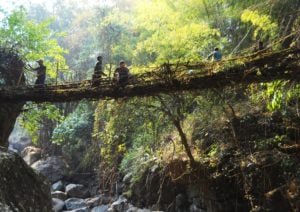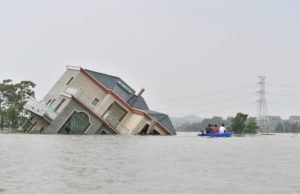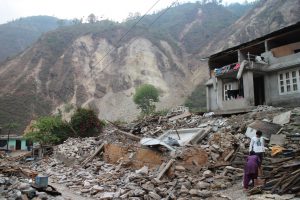In the second half of August, the waters started receding from the latest round of floods in Assam. After killing over 100 people, displacing millions and damaging crops and property worth billions, they left behind a deposit of sand rather than fertile silt on farmland. All residents know they will now struggle to make ends meet before the inevitable next round of floods.
Over the centuries, people living close to the many rivers of the Brahmaputra basin have learnt to live with minor floods. They built their houses on stilts to let the floodwaters flow below and they profited from the fertile silt left behind when the floodwaters receded.
But in recent decades, floods have become a cycle of disasters due to a combination of climate change, ill-planned dam building and embankments that stop minor floods but fail to prevent the bigger ones.
See: Guwahati gets an experimental flood warning system
The most important impact of climate change on the flood cycle is there are fewer rainy days during the monsoon, but heavier rainfall on those days. Added to this is faster snowmelt due to higher temperatures in the glacier region where most of the rivers originate, either in Tibet or in India. This means all the rivers are already carrying more water during the summer due to snowmelt, and on top of this there are huge water pulses caused by very heavy rainfall over a short period of time.
This year, the problem started even before the monsoon reached Assam. After devastating the southern districts of West Bengal – including Kolkata – and adjoining parts of Bangladesh on May 20, Cyclone Amphan petered out in the Brahmaputra valley that takes up most of Assam. This meant that all the moisture the cyclone retained fell as rain in the valley. The flooding started at once.
Heavy early monsoon rains adding to these woes were expected, but the flooding became disastrous – as it has been every year in recent memory – due to two kinds of ill-planned engineering: dams and embankments.
Dams hold back or divert almost all the water in almost all the rivers of the basin now. Flood control is one of the stated reasons for building dams. But in recent years, dam managers have been forced to open the gates every monsoon to save the structures – and that leads to a more ruinous flood pulse than would have occurred otherwise.
Stopping silt
The other huge problem with dams is that they stop silt. Being the youngest mountain range in the world, the Himalayas are still crumbling, and rivers flowing down from this range carry the crumbling rocks in the form of very fertile silt. For centuries, this rejuvenated the farmlands of south, south-east and east Asia. This is why the floodplains of the Ganga-Brahmaputra-Meghna, Aerawaddy, Chaophraya, Mekong, Pearl and Yangtze rivers have provided the world’s most fertile farmlands.
Not any more. With the silt stopped behind dam walls, floodwaters only scour out the riverbanks without building fresh land with the silt. On top of this erosion, the rushing floodwaters scoop out sand from the riverbeds and spread it over farmland, making the soil infertile when the water recedes.
This imbalance between erosion and silt deposition in recent decades has been documented from 1988 to 2015, through satellite imagery analysed by the Assam government’s Brahmaputra Board. It found 798 square kilometres had been eroded, while 208 sq km of fresh farmland had formed through deposition.
The Chinese government has built and is building four hydropower projects on the Yarlung Zangbo, as the Brahmaputra is called in China. It claims that three of the four are run-of-the-river projects that don’t hold back any water. But they do hold back silt.
On the Indian side, the big dams on the anvil right now are the Dibang valley and Lower Subansiri projects. Plus, at least 168 agreements have been signed between the state government of Arunachal Pradesh and dam building companies. This in a situation where floods have been significantly worsened by the release of water from the Ranganadi, Kopili and Doyang projects. Engineers from India’s Central Water Commission, who manage the Kurichu dam in Bhutan, have also opened the floodgates, resulting in submergence in western Assam.
Unkept promises
The current Assam government vowed to oppose big dams just after it was voted to power. But since then, it has done nothing to keep that promise.
“In 1980, the government started planning big dams. Earlier, the animals knew how to escape the floods and the people knew how the river behaved,” said Mirza Zulfiqur Rahman, visiting research associate at the New Delhi-based Institute of Chinese Studies. “Now, the government has invested so much into interventions that the people have lost their traditional methods to cope with the river.”
“These infrastructures don’t improve the situation because the people continue to suffer; this is just a political play. The core problem with the government is that it does not have a holistic understanding of the ecological landscape. Any solution you introduce to the river basin without studying the ecology of the area will be unsuccessful.”
As well as the dams, there is the ad hoc building of embankments in an effort to control floods. For decades now, Assam has suffered because embankments keep being damaged or washed away altogether whenever a large flood occurs. Allegations of poor planning, corruption and shoddy construction are as old as the embankments. Still, the authorities’ default option every year is to build more embankments while they repair and strengthen old ones, only to see them washed away again. And again.
Rahman pointed to another negative effect of embankments: they cannot stop the floodwaters from submerging the land, but they do stop the floodwaters from receding back into the rivers. So the land remains waterlogged much longer than it would have otherwise.
“Before the embankments were built, the floodwater had space to come and go,” he said. “But now it cannot go back. This waterlogging means more diseases and a loss of farmland.”
Overall, Rahman said, “In the past 60 years due to the embankments, the floods have become worse. The Assam government feels it has a solution for everything and does not require consultation or advice. The government only talks to engineers and not to social scientists. The local communities have no environmental democracy. They cannot make any decision on the river.”
There are successful ways to control floods. The commonest is to drop boulders at an angle next to the riverbank, so that the flow is diverted. When done properly, it works; reduced erosion near the towns of Dibrugarh and Dhubri are proof. Another way is to drop permeable screens. They trap silt, which prevents erosion. In some of the smaller rivers of the basin, residents have traditionally used bamboo fences as permeable screens.
This article was first published by India Climate Dialogue, one of The Third Pole’s partner sites. Karmistha Bhimwal is a student at the Jindal School of Journalism and Communication, OP Jindal Global University. She is doing an internship at India Climate Dialogue
![<p>The catastrophic floods in Assam in September 2015 [image by Mubina Akhtar]</p>](https://dialogue.earth/content/uploads/2015/10/Assam-floods.jpg)

![The expedition to climb Lalana was an adventure that none of the people on it would forget; Sudipta (right) and Kamala [image by: Sudipta Sengupta]](https://dialogue.earth/content/uploads/2020/09/Photo-08-300x216.jpg)





